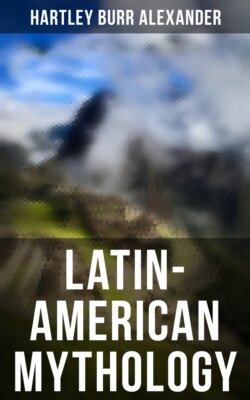Читать книгу Latin-American Mythology - Hartley Burr Alexander - Страница 6
На сайте Литреса книга снята с продажи.
ОглавлениеCHAPTER I
THE ANTILLES
Table of Contents
I. THE ISLANDERS6
Table of Contents
A glance at a map of the Western Hemisphere reveals two great continents, North and South America, somewhat tenuously united by the Isthmus and the Antilles. The Isthmus is solid, mountainous land, forming a part of that backbone of the hemisphere which extends along its western border, continuous from Alaska to the Land of Fire. The Antilles are an archipelago, or rather a group of archipelagos, extending without gap from the tip of Florida to Trinidad and the mouths of the Orinoco. Both connexions have a certain weight, or leaning, toward North America. The Isthmus narrows southward almost to the point of its attachment to South America, while to the north it broadens out into Central America, the peninsula of Yucatan, and the plateau of Mexico. Similarly, the southern division of the archipelago, the Lesser Antilles, forms an arc of islets, mere stepping-stones, as it were, from the southern continent to the large islands of the Greater Antilles—Porto Rico, Hispaniola or Haiti, Jamaica, Cuba—which are natural outliers of the continent to the north. Cuba, indeed, almost unites Yucatan and Florida; while breasting Cuba and Florida, toward the open sea, is a third island group, the Bahamas, still further emphasizing the northern predominance.
There is a superficial resemblance between the connexions of the northern and southern land bodies in the Old World and in the New—the Isthmus of Suez having its counterpart in Panama; the peninsulas and large islands of southern Europe corresponding to Florida, Yucatan, and the Greater Antilles; and the break at Gibraltar suggesting the uncertain bridge of the Lesser Antilles. But the resemblance is merely superficial. The Mediterranean served far more as a unifier than as a divider of cultures and civilizations in antiquity; all its shores were in a sense a single land even before Rome united them politically. The Caribbean, on the other hand, was a true obstacle to the primitive intercourse of the western continents, having its proper Old World analogue in the Sahara Desert rather than in the Mediterranean Sea. In fact, we can carry this truer analogy a step further, pointing out that just as Old World culture went southward, from Egypt into Ethiopia, by way of the comparatively secure route of the Nile, so New World civilization found its securest path by way of the solid land of the Isthmus, while the islets of the Lesser Antilles and the isle-like oases of the Sahara were alike unfriendly to profoundly influential intercourse.
In one striking particular the analogies of the Old World are reversed in the New: at least in recent periods, the migration of native races and culture has been from the south to the north. This is the more extraordinary in view of the land predominance which, as has been indicated, belongs to the north. The Isthmus was held by, and is now representative of, the Chibchan stock, extending far south into Ecuador; while the Antilles, at the time of the discovery, were almost entirely possessed by tribes of two great South American stocks, Arawakan and Carib. In Cuba, and probably in the Bahamas, there were remnants of more ancient peoples—timid and crude folk, whose kindred seem to have been the makers of the shell-mounds of Florida, and whose provenience was doubtless the northern continent; but neither the race nor the affinities of these vanished peoples is certainly known; even in pre-Columbian times they were succumbing to the war-like Calusa of southern Florida and to the still more dangerous Arawakan tribes from the south.
Of the two powerful races from the south, the first comers were doubtless the Taïno7 (as the Antillean Arawak are named), whom the Spaniards found in possession of most of Cuba and of the other greater islands, Porto Rico alone showing a strong Carib element along with the Arawak. The Lesser Antilles, bordering the sea which was named for their race, was inhabited by Carib tribes, whose language comprised a man-tongue and a woman-tongue, the latter containing many Arawak words—a fact which has led to the interesting (though uncertain) inference that the first Carib invaders slew all the warriors of their Arawak predecessors, taking the women for their own wives. Only when they came to Porto Rico, the first of the Greater Antilles in their route, were they partially stopped by the mass and strength of the more highly developed Taïno peoples; some, indeed, obtained a foothold here, while beyond, in Hispaniola, one of the five caciques8 dividing the power of the island was reputed a Carib, and in Cuba itself have been found bones believed to be those of Carib marauders. The typical culture of the Antilles, that of the Arawakan Taïno, was scarcely less aggressive than the Carib. Arawaks gained a foothold in Florida, and their influence, in trade at least, seems to have extended far into Muskhogean territories to the north, while it may have affected Yucatan and Honduras to the west. Nor was it meanly savage in type. The Antilles furnish every incentive of climate, food supply, rich resources, and easy communication for development of civilization; and at the time of the discovery of the Taïno peoples, they were already advanced in the arts of agriculture, pottery-making, weaving, and stone-working, combined with some knowledge of metals. Furthermore, they had developed their social organization to such an extent that their chiefs, or caciques, with power in some cases hereditary, were the heads of veritable nations—all of Jamaica was under one ruler, Hispaniola had five, while the Ciboney of Cuba and the Borinqueño of Porto Rico were powerful peoples. The Spanish conquerors of the islands succeeded early in virtually annihilating these nations, but their handiwork and the traditions which they have left still command respect.
